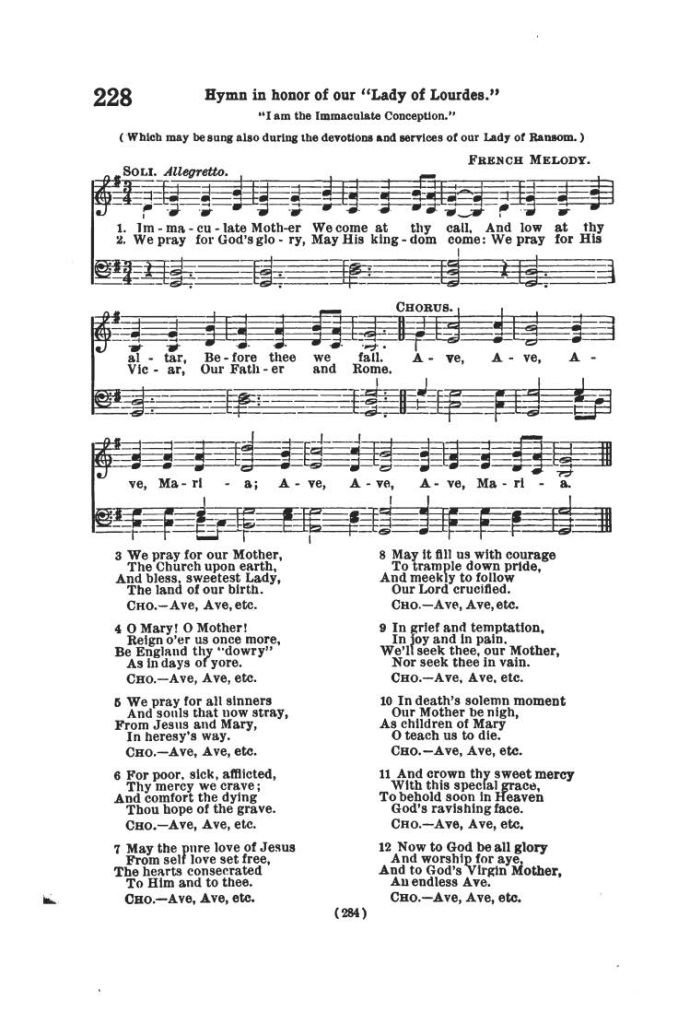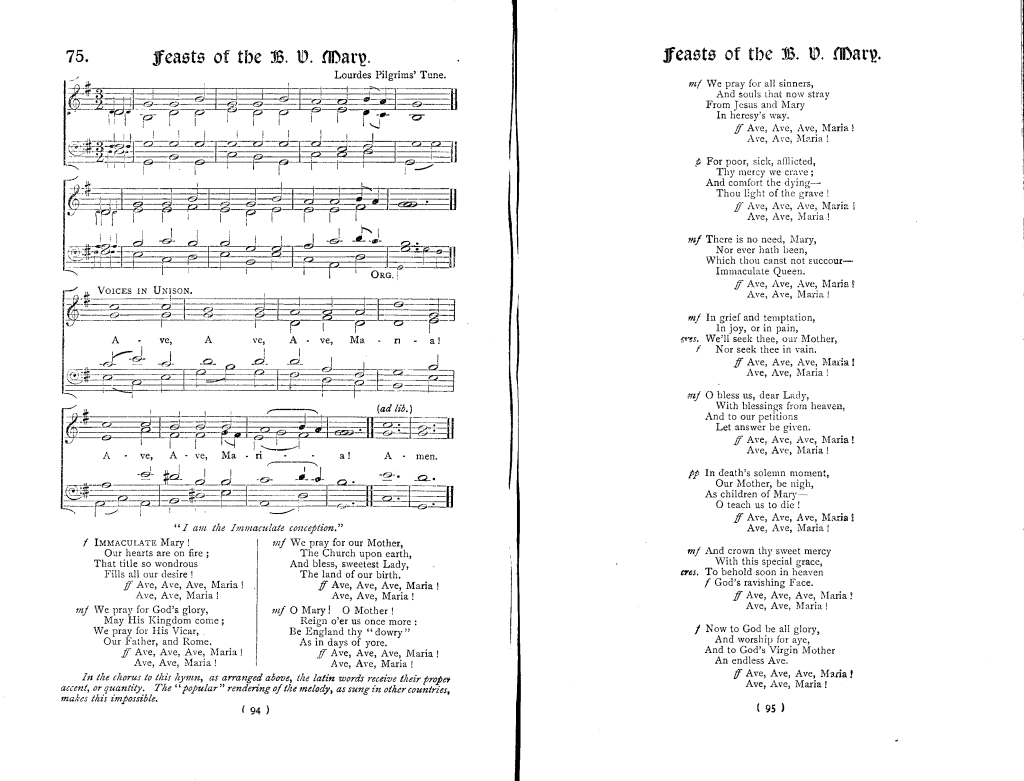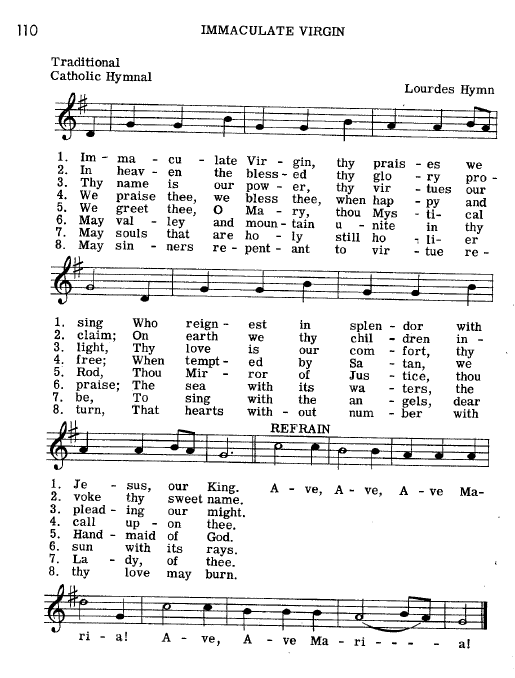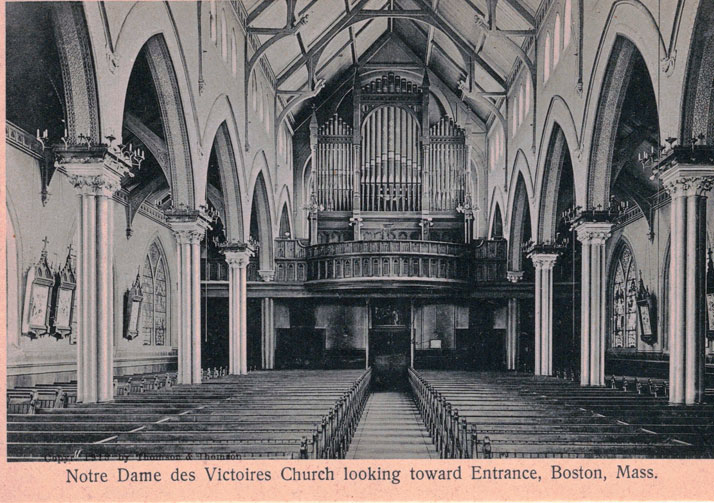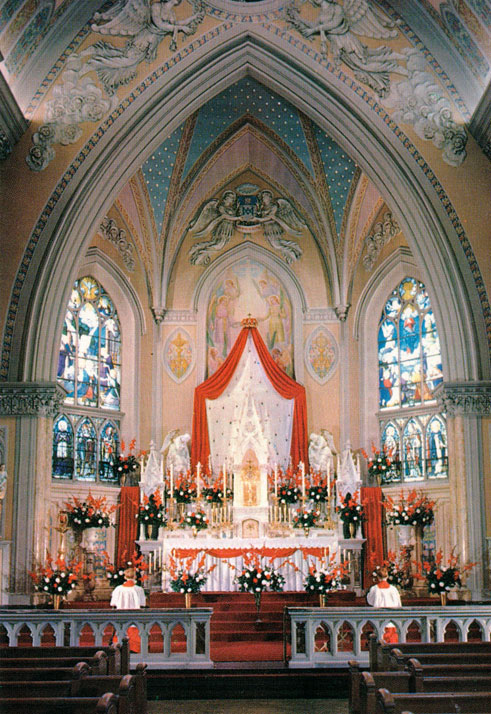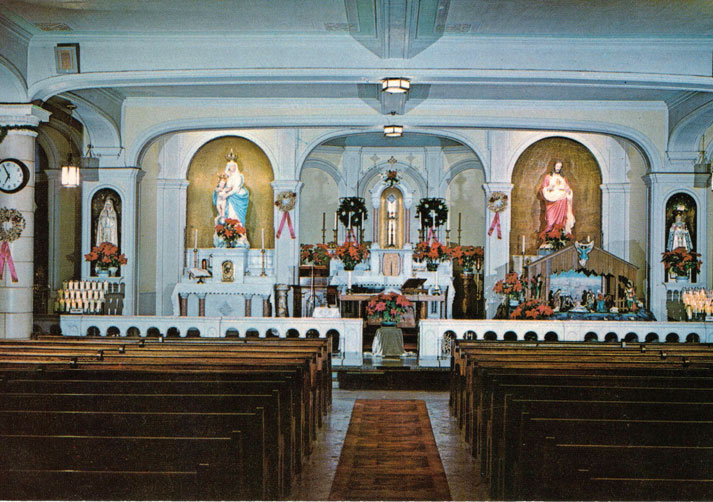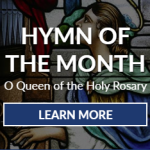The author of this hymn is not known. The verses that we sing today are thought to be a translation of a French hymn originally authored by Abbot Jean Gaignet (1839-1914) in the 1870s. An interesting article appeared in the Catholiques en Vendee, a diocesan bulletin of Luçon, France in 2015. In summary the article recounts the events of the 140th anniversary of the Vendée pilgrimage to Lourdes and how the Abbot Gaignet authored the hymn.
Abbot Jean Gaignet was a professor at the Major Seminary of Luçon when he wrote the Salut d’arrivée, a sort of greeting to Mary. This hymn was dedicated to the Virgin Mary and consisted of eight verses intended for Vendée pilgrims going to the Grotto of Lourdes. The hymn became an immediate success and was loved by all the faithful. The Bishop of Luçon then asked Abbot Gaignet to write a long version which would describe all the apparitions of the Virgin at Lourdes and would accommodate the lengthy procession of pilgrims.
Accordingly, he wrote sixty-eight verses which recount all the apparitions of the Lady of Lourdes. The Salut d’arrivée or Arrival Greeting then became the le chapelet de Notre-Dame de Lourdes, meaning, the rosary of our Lady of Lourdes. This composition received the Imprimatur of the Bishop of Luçon and the Bishop of Tarbes.
Each country and culture have produced their own version of the verses. These variations can be found in different regions of a country, its population, from town to town, from village to village, or across a span of time. (see below) Some follow the apparitions of Lourdes while some are expressions of our devotion to Mary Immaculate, and still others are petitions or a combination of all three.
French, Massabieille 1870s |
La terre à Marie disait le salut La Vierge bénie Soudain apparut Chorus Ave, Ave, Ave, Maria! Ave, Ave, Ave, Maria!
Une enfant candide, Au souffle du ciel Regarde timide Au roc Massabiel (Chorus) Celeste et bénigne, La Dame à l’enfant Sourit et fait signe De son front brillant (Chorus) Bernadette émue A genoux tombait L’enfant ingénue Prit son chapelet (Chorus) Plus twenty-three more verses Source: Les Echos De Massabieille Chants Populaires De Lourdes, 1872 |
England & U.S., 1898 – 1950s |
Immaculate Mary! Our hearts are on fire, That title so wondrous Fills all our desire ! Chorus Ave, Ave, Ave, Maria! Ave, Ave, Maria!
We pray for God’s glory, May His Kingdom come We pray for His Vicar, Our Father, and Rome. (Chorus) We pray for our Mother, The Church upon earth, And bless, sweetest Lady, The land of our birth (Chorus) O Mary! O Mother! Reign o’er us once more Be all lands* thy dowry As in days of yore. (Chorus – *England) Plus twelve more verses Source: Catholic Hymns, 1898 |
1950s – Today |
Immaculate Mary, Your praises we sing, You reign now in heaven With Jesus our King Chorus Ave, Ave, Ave, Maria! Ave, Ave, Maria!
In heaven the blessed Your glory proclaim On earth we your children Invoke your fair* name (Chorus – *sweet) We pray for our Mother, The Church upon earth And bless, Holy Mary, The land of our birth (Chorus) No more verses Source: Breaking Bread, 2023 |
Despite the wide spectrum of verses, what remains traditional to the hymn are the Ave’s. And yet, even among the Ave’s there are differences. In some countries and cultures we have a refrain of six Ave’s, while in our missalettes and pew missals today we have only five Ave’s. There also exists somewhat of a controversy regarding the musical accent given to the Ave.
On an aside, it has been suggested that the hymn text we sing today for Immaculate Mary was taken from or is a replacement for another hymn Hail, Virgin of Virgin’s Thy Praises We Sing, written by Father Jerimiah Cummings in 1860 for the Feast of the Assumption. This hymn appeared in his hymn book SONGS FOR CATHOLIC SCHOOLS. Only in the first line of text can it be shown that there is any similarity. Like many of the hymns that honor Our Blessed Mother, Hail, Virgin of Virgin’s was removed and largely forgotten except by a few hymn researchers, hymnologist, and vintage organist. To learn more about this wonderful Marian hymn click on the links in this paragraph and visit The Devotional Hymns Project website and listen to a newly commissioned recording.
The earliest appearance of the hymn in English that we know as Immaculate Mary is found in the PAROCIAL HYMN BOOK published in 1897. It is captioned a Hymn in honor of our Lady of Lourdes, and the first line of text is Immaculate Mother, we come at thy call. This hymn book was compiled by Father Anatole Police, S.M., a Marist priest. He published two earlier editions of the PAROCHIAL HYMN BOOK in 1881 and 1883 while living in London. The hymn Immaculate Mary or Immaculate Mother does not appear in these earlier editions. Father Police came to Boston in the spring of 1891. (Click on any image to enlarge)
Immaculate Mary also appeared in CATHOLIC HYMNS published in 1898 in London, England. This hymnal was compiled by Augustus Edmonds Tozer. This collection of hymns was identified by J. Vincent Higginson (aka Cyr De Brant) to be a musical edition of ST. DOMINIC’S HYMN BOOK, with three editions published between 1885 and 1887. St. Dominic’s Hymn Book is a collection containing many older texts by Father Faber, Father Caswall, Father Aylward, Father Stanfield, and others. The hymn Immaculate Mary does not appear in the 1885 edition of St. Dominic’s Hymn Book referenced above. Augustus Edmonds Tozer (1857-1910) was a convert to Catholicism and received his Doctorate from Oxford University and was named a Knight of St. Sylvester for his work in the reform movement in England. His CATHOLIC CHURCH HYMNAL published later was helpful in church music reform in both England and America.
These early hymn books published by Father Police and Augustus Tozer are particularly significant to the hymn we know today as Immaculate Mary. Both hymns are set to the Lourdes Pilgrim Tune, with similarities in the verses and musical variations in the Ave’s.
Father Police’s version of the hymn quickly faded from the Catholic repertoire whereas, Augustus Tozer’s Immaculate Mary, our hearts are on fire with its five Ave’s would become the standard in Catholic hymn books until the 1950s.
In the 1950s, the hymn text was revised to Immaculate Virgin, thy praises we sing. This revision first appeared in the CANTATE OMNES hymnal published by the Catholic Choirmasters’ Guild of Buffalo, New York in 1952.
Later, in THE PEOPLE’S HYMNAL compiled and edited by The Hymn Committee of The Theological College in Washington D. C., published in 1955 we learn why the lyrics were changed and the reasoning behind it. Below is an excerpt from the Introduction of that hymnal.
Catholic devotion, as the Church takes care to emphasize, should represent, not what we would wish to feel, but what we actually feel. There is no need for saying our hearts are on fire when really thy are not. This device exalts the emotions at the expense of reason. The whole tradition of Catholic devotion opposes the fabrication of an external devotion with poetic conceits and painfully drawn figures of speech which does not in the least represent our interior dispositions.
The hymn must express, not what makes its subject so sweet or beautiful alone, but what makes it so holy, magnificent, and lovable, so worth singing to and about. THE PEOPLES HYMNAL strives, therefore, to avoid every meretricious pretense of emotion, and replace this all-too-common hymnology with compilation of hymns meant to arouse a mature, honest, and integrally human response.
In preparation for my HYMN OF THE MONTH, and as part of my research, I conduct a hymn survey from my own collection of Catholic hymnals. You can read more about my methods of research in a special write-up Conducting Hymn Research. This list often times is quite lengthy and to keep page scrolling to a minimum, I have been providing a link to the survey. However, this time I decided to present the survey based on the first line of text from the hymn covering a time period from the hymns first appearance in 1897 to the present day. And so…
The hymn Immaculate Mother, we come at thy call, and low at thy altar, Before thee we fall appeared in the following Catholic hymnals:
- The PAROCHIAL HYMN BOOK, published in 1897 Boston, and compiled by Father Anatole Police, S.M.
- The DE LA SALLE HYMNAL, published in 1913 and compiled by the Brothers of Christian Schools of New York.
- The DIOCESAN HYMNAL PART 2, published in 1926 and compiled by Bishop Joseph Schrembs of Cleveland, Ohio.
The hymn Immaculate Mary, our hearts are on fire, That title so wondrous fills all our desire! appeared in the following Catholic hymnals:
- CATHOLIC HYMNS, published in 1898 London, and compiled by Augustus Edmonds Tozer.
- The CATHOLIC CHURCH HYMNAL, published in 1906 and 1933, compiled by Augustus Edmonds Tozer.
- The CROWN HYMNAL, published in 1913, compiled and edited by Father Leslie J. Kavanagh and James M. McLaughlin. Father Kavanagh was elevated to Monsignor in 1919 and James McLaughlin was partners with James A. Reilly of McLaughlin & Reilly music publishing company.
- The BOOK OF HYMNS with TUNES, published in 1913 London and New York, and edited by Father Samuel G. Ould, O.S.B. and William Sewell.
- The ST. BASIL’S HYMNAL from 1918 thru 1953 and compiled by the Basilian Fathers of Toronto, Canada.
- The ST. MARY’S HYMNAL, published in 1924 and 1944-1950 New York, compiled by Christian Zittel.
- SELECT HYMNS, published in the 1930s, text only and references the CROWN HYMNAL.
- The GLORIA HYMNAL, published in 1933, was compiled by the Basilian Fathers.
- The ORDINARY OF THE MASS and a COMPLETE MANUAL OF HYMNS, published in 1933 Philadelphia, text only.
- SING TO THE LORD – A COLLECTION OF CATHOLIC HYMNS AND PRAYERS, published in 1946 Boston, and compiled by Archbishop Richard Cushing, D.D., introduction of a new refrain in English in addition to the traditional Ave’s.
- The HOLY NAME HYMNAL, published in 1947 and compiled by Father J. J. McLarney, O.P., uses the same English text for the refrain as well as the traditional Ave’s as found in SING TO THE LORD.
- The MANUAL OF HYMNS FOR CATHOLIC SCHOOLS, published in 1948 was compiled and edited by The Voshardt Press, text only. The hymns are taken from St. Basil’s, St. Gregory, Cantate Domino, Catholic Church, and the American Catholic Hymnal.
- The JUBILEE HYMNS BOOK II, published in 1949 Toronto and edited by Father James E. Ronan. Father Ronan was later elevated to Monsignor.
- The MONASTARY HYMNAL, published in 1954 Boston and compiled, edited, and arranged by Achille P. Bragers.
- The MEDIATOR DEI HYMNAL, published in 1955 by the Gregorian Institute of America and compiled by Cyr De Brant – a pseudonym for J. Vincent Higginson.
- The PARISH HYMNAL, published in 1957 by the Gregorian Institute of America.
- The CATHOLIC CHAPEL HYMNAL, published from 1944 thru 1968 compiled by Edward Grey and Edward Curry.
- The ST. ANDREW HYMNAL, published in 1964 and authorized by the Archbishop’s of Scottland for the use in the Scottish Dioceses.
- The CATHOLIC HYMNAL & SERVICE BOOK, published in 1966, part of the Benziger Editions with approval by the Commission on Church Music, Archdiocese of New York.
- The CATHOLIC BOOK OF HYMNS & CHANTS, published in 2020 by the Sacred Music Library.
The hymn Immaculate Virgin, thy praises we sing, Who reignest in splendor with Jesus our King, and Immaculate Mary, thy praises we sing, Who reignest with Christ, our Redeemer and King appeared in the following Catholic hymnals:
- The CANTATE OMNES published in 1952, was compiled and published by the Catholic Choirmasters’ Guild from Buffalo, New York
- The PEOPLE’S HYMNAL, published in 1955, compiled by The Hymn Committee of The Theological College in Washington, D.C., printed by World Library of Sacred Music
- The NEW ST. BASIL HYMNAL, published in 1958, was compiled by the Basilian Fathers and printed by Willis Music Company in Cincinnati, Ohio
- The BVM HYMNAL, published in 1961, is the Official Hymn Book of the Sisters of Charity of the Blessed Virgin Mary from Dubuque, Iowa. Distributed by the Gregorian Institute of America.
- The ADOREMUS HYMNAL, published in 2011, compiled by the Adoremus Society of the Renewal of the Sacred Liturgy, with approval by the Committee on Divine Worship United States Conference of Catholic Bishops.
The hymn Immaculate Mary, your praises we sing, You reign now in splendor with Jesus Our King and Immaculate Mary, your praises we sing, You reign now with Jesus, Our Savior and King appeared in the following Catholic hymn books.
- OUR PARISH PRAYS AND SINGS, published in 1973 by the Liturgical Press, St. John’s Abbey, Collegeville, Minnesota.
- The CATHOLIC HYMNAL – Hymns for Liturgical Celebration, published in 1974 by Our Sunday Visitor.
- GLORY & PRAISE, published in 2001 by Oregon Catholic Press.
- The CHORAL COMPANION, published in 2006 by World Library Publications.
- GATHER HYMNAL 3rd edition, published in 2011 by the Gregorian Institute of America
The Melodies
In my quest to find the origin of the melody, I came across a few interesting stories. One story indicates the melody comes from the mountainous region of Southwestern France known as the Pyrenees, and it was brought back to Luçon, France by the French Catholic priest Abbot Jean Gaignet (1839-1914). In this account, Abbot Gaignet went on a retreat after learning two of his brothers were killed in the Franco-German war of 1870. While there he heard the melodies and brought them back when he returned to his priestly duties. This Pyrenean melody became the traditional melody we know today as the Lourdes Pilgrims’ Tune.
Another story takes us to the small town of Berlaar, Belgium where it is said the melody was composed by Constant Verhulst (1838-1923) in 1857, for a Feast of Mary in Berlaar, a year before the apparitions of Lourdes. After the apparitions, a nun in Berlaar wrote the words to a song te Lourdes op de bergen meaning in Lourdes on the mountain to the tune of Constant Verhulst. I haven’t been able to verify that Constant Verhulst composed the melody but only that the song uses the traditional Lourdes Pilgrim tune.
A different story suggests the melody was borrowed from a hymn composed by Fr. Louis Lambillotte, S. J., in 1842, and references his CHOIX DE CANTIQUES SUR DES AIRS NOUVEAUX, but does not indicate which hymn. Father Lambillotte (1796-1855) was a French Jesuit priest who composed several melodies that are still used today including: On This Day O Beautiful Mother; Come Holy Ghost, Creator Blest; ‘Tis the Month of Our Mother; Panis Angelicus; Mother Mary, at Thine Altar, and many more.
Somewhat of controversy exists regarding the famous refrain Ave, Ave, Ave Maria! In my small collection of French hymnals, the refrain contains six Ave’s. In the United States, five Ave’s in the refrain has been the standard for over 120 years. The origin of the five Ave’s can be traced back to Tozer’s CATHOLIC HYMNS, 1898. He was the first to alter the refrain of melody by giving the Latin Ave its proper accent. Some feel this revision removes the folk quality of the French Avé.
Reflection
I grew up singing Immaculate Mary, thy praises we sing, You reign now in splendor with Jesus Our King. I will probably always remember it with those words. But I also like the words of the hymn that was used by my parents and grandparents Immaculate Mary, our hearts are on fire, That title so wondrous fills all our desire!
I presented the reasoning why the words were changed, but I question whether there was any wisdom in that choice. Afterall, the apostle’s on the road to Emmaus declared, We’re not our hearts burning inside us as he talked to us on the road and explained the Scriptures to us (Luke 24:32).
I wonder if the apostle’s hearts were really on fire or if they chose to exalt their feelings at the expense of reason.
Father Anatole Police, S.M.
I recently received new information from the archivist for the Society of Mary, U. S. Province on Father Anatole Police, S.M., who compiled and edited the PAROCHIAL HYMN BOOK here in America and in England between 1881 and 1897. Father Anatole Police was born in 1834 in the diocese of Bayeux (Calvados), France. He professed his vows in 1861 and was ordained in the same year at Belley, France. He spent twenty-six years at St. Anne’s in London, England and the last seven years of his life at Our Lady of Victories in Boston. MA.
His French colleagues considered him more English than French. He completed the work on the upper Church of Our Lady of Victories at the death of Father Firmin Coppin (1838-1891). Father Anatole was an accomplished musician and was responsible for the acquisition of the original organ, a Hook and Hastings Opus #1531 that was installed in 1892. The original organ would be replaced by a Casasvant Opus #1484 in 1933. Nothing was retained of the Hook and Hastings organ except for the pipe work and its entire case. The Casavant organ was still in use in 1986.
The work on the upper church of Our Lady of Victories began in the spring of 1891, but at the same time, Father Coppin, although only 53, became seriously ill and had to allow Father Police who had recently arrived from London, to take charge. The work of construction on the upper church went on through the summer and was finally finished in November. But Father Coppin was not there to see it. A month before, on October 16, 1891, he died.
Father Police, who had been in charge during the illness of Father Coppin, remained as administrator until the new pastor arrived. This would be Father Descreux, who came in August, 1892. After the arrival of Father Descreux, Father Police stayed on as assistant for another six years, till his death in 1898 at the age of almost 64.
Father Police was an outstanding musician and editor of the American PAROCHIAL HYMN BOOK which was published in 1897. He also was the editor of the Manuel de Cantiques et Chants Religieux published in Boston in 1893 and it is thought that this is a French edition of the Parochial Hymn Book. In my examination of this French collection I found a few hymns with popular melodies. For example:
- Regina Coeli composed by M. Labat. This arrangement of Regina Coeli appeared in the St. Basil Hymnals from 1891 thru 1918. I sang this with St. Mary’s Choir in the 1980’s.
- Another hymn, L’AMOUR DU COEUR DU MARIE uses the same melody as the hymn To Jesus’ Heart All Burning, with fervent love for all men composed by Wm. J. Maher.
- Adeste Fideles, although the French hymn is captioned CE PETIT ENFANT EDT NOTRE DIEU, ADORONS LE which loosely translates to This Little Child is Our God, Lets Worship Him.
- The Ave Maris Stella, with Latin text and a melody by Father Louis Lambillotte, S.J.
- LA PENTECÔTE, ESPRIT-SAINT, DESCENDES EN NOUS, to the melody for Come Holy Ghost, Send Down Those Beams.
- There is a section of Benediction hymns and Litanies common to most Catholic hymnals of that time period with Latin text and traditional melodies.
Father Police was widely known in Boston for his devotion to the ministry of confessions, and for his establishment of the English-speaking confraternity of the Third Order of May. He was loved by his parishioners, and all who knew him. His winsome ways encouraged co-operation in the task of embellishing the newly constructed upper church. During his brief year as administrator many finishing touches were added.
The exterior statues of Our Lady of Victories were put on the facade, donated by Caroline Aubry. The statues of Our Lady of Victories and most others in the upper church were imported from France. In 1892, the three altars were erected in the upper church: the main altar being donated by Mr. Louis P. Ober; that of the Blessed Virgin Mary, by Mr. Lomer Lahaise; and that of the Sacred Heart by Mrs. John Dean.
Father Police died in April of 1898, at the Carney Hospital in Dorchester, MA, at the age of nearly 64, He is buried at Holy Cross Cemetery in the Clergymen’s section as Anatole Palici in Malden, MA.
Sadly, Our Lady of Victories Church was permanently closed in 2016.
A special thank you to Peter Meggison, producer of The Devotional Hymns Project for the post cards of Our Lady of Victories which show the original Hook and Hastings Organ, the upper church and the lower basement church.

